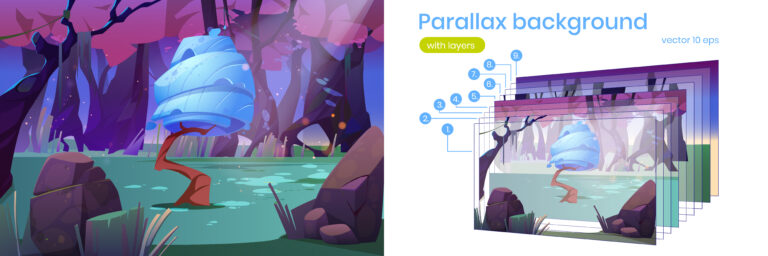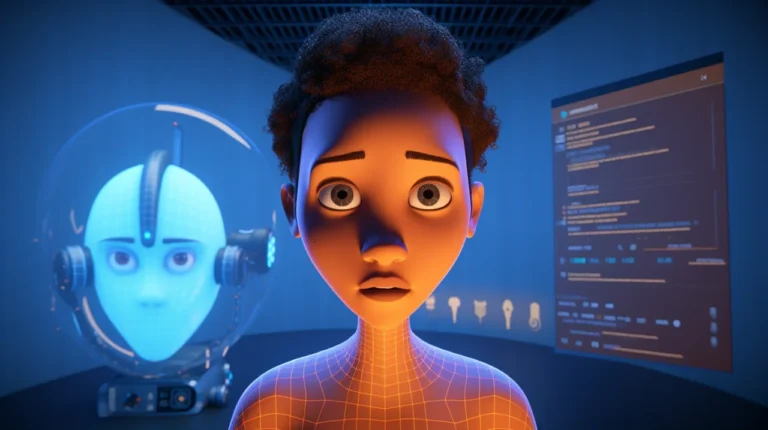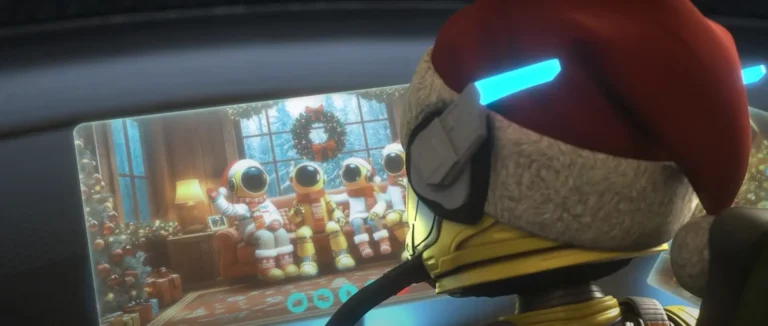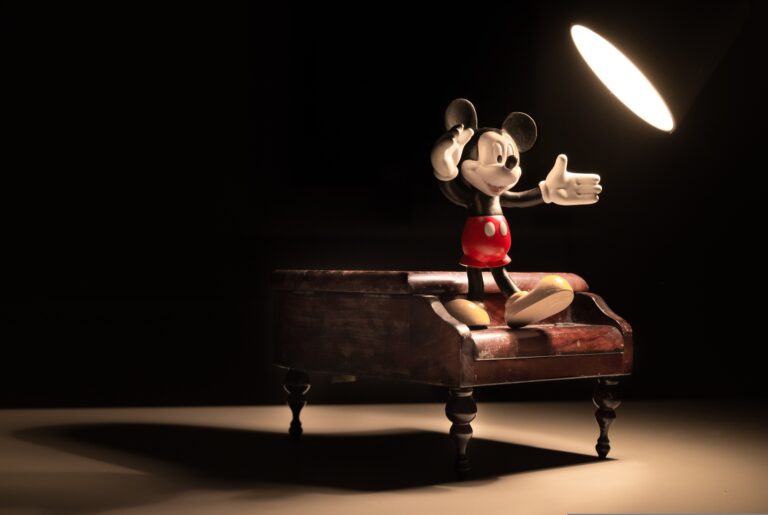3D modeling techniques have come a long way in the past decade. From software applications like Blender and 3ds Max to increasingly accessible 3D printers, the ability to craft objects from digital models is becoming more widespread than ever before. Some of the best techniques for creating precise and high-quality 3D models are box modeling, polygon modeling, curve modeling, etc. Read on as we explore some of the most popular 3D modeling techniques for producing stunning 3D models – from manipulating traditional geometry to using cutting-edge simulations, and discuss how you can use them to bring your designs to life. Let’s dive in!
A Recap on the 3D Modeling Process
Every 3D object seen in a 3D animation is composed of a 3D mesh, which can be constructed in a number of different ways. Simply, the 3D modeling process is producing mesh objects in 3D software. These objects, which will be used as components of the 3D environment we’re attempting to construct, are made based on earlier designs or real-world observations. As you know, a 3D model can be the final product of a 3D animation pipeline.
Drawings and occasionally sculptures make up the majority of the design data. A modeling artist’s responsibility is to accurately reproduce these objects’ geometry in a 3D modeling environment. In fact, 3D models must be tuned for a variety of movement-related malformations; otherwise, they would appear quite strange.
Three-dimensional photographs of various items that are mathematically represented in three dimensions are produced using 3D modeling techniques. A group of vertices that make up an item is created by an artist manipulating points in virtual space. 3D objects can be generated automatically or manually by manipulating vertices.
These methods are applied in a range of industries, including engineering, architecture, motion pictures, animation, and even advertising. These methods are used by engineers and architects to plan and create their work. On the other hand, designers and animators use it for character animation and special effects. Don’t forget that software talks! Due to the number of 3D modeling software available, it can be challenging to decide which is the best for your needs so find out about the 11 best 3D modeling software.
Need Game Art
Services? Visit our Game Art Service page to see how we can help bring your ideas to life!

Different Types of 3D Modeling Techniques
One could contend that modeling forms are as varied as tool types. Here is a short selection of techniques with which a slightly larger audience is familiar. These techniques appear to be widely recognized as techniques or kinds of 3D modeling.
In one way or another, they are all feasible, it just depends on the type of form and level of detail you hope to achieve. Many of these types are functional with Blender or other tools. This blog seeks to promote a wider perspective and examine the advantages and disadvantages of each style of modeling.
Box Modeling
Let’s begin with modeling boxes. In order to generate a shape from a basic item, such as a cube or sphere, we employ traditional modeling tools, which distinguish box modeling as a distinct type. To build our item, we start with a base shape and use low polygon count shapes.
Since we can individually control faces, edges, and vertices, this method of modeling is extremely mechanical. With box modeling, the focus is on manipulating entire shapes and more substantial chunks of an item at once.
We refer to faces with four sides as quads most of the time while working with them. Since most modeling tools are made to deal with quads, these are simple to use. However, a model is frequently triangulated beforehand, either manually by the user or automatically by the program in the background.
Hard-surface items, such as architectural visualization and manufactured goods, seem to operate well with this kind of modeling. Extrusion, loop cuts, and beveling are some of the tools we employ. Box modeling and subdivision surfaces are frequently used together.
Using a technique called a subdivision surface, we may add additional geometry between the edges, vertices, and faces that we can alter using conventional modeling tools. The geometry we are in control of acts as a cage to mold the divided form of our object. you may find the whole needed tutorial in the box modeling a simple character from scratch to this end.
Polygon Modeling
Box modeling and polygon modeling are both forms of 3D modeling. The distinction is that we often begin with a single vertex or a flat, simple shape. Then, we gradually assembled our model. The same techniques that we used for box modeling are frequently deployed but in a more detailed manner.
Here, working with edges and vertices more is the key. The kind of objects we produce using this method still frequently have hard surfaces but have more organic shapes. Similar to box modeling, polygon modeling frequently highlights the use of quads in the topology. This is so because a lot of tools are made to operate in a quad topology.
This polygon-modeled object that we produced may be considered as hard surface modeling. However, the models we develop frequently have certain organic characteristics. For instance, it may be a statue or architectural decorations.
However, we can also use this process to make any sort of accessory, tool, or other equipment. Here, as well, the geometry of the item is frequently smoothed with a subdivision surface. Although we use them differently, the tools used for box modeling and polygon modeling are essentially the same. Mastering different pieces of software is required for any single technique you want to apply, for further information about different software check out the 6 best animation software for animators.

Nurbs and Curve Modeling
NURBS stands for non-uniform rational b-spline. We have an acronym for a reason. We transition to an entirely different type of modeling using this style of modeling. Using control points, we generate curved surfaces that can be manipulated. It enables the creation of incredibly smooth curved surfaces.
Engineering and CAD-like tools are the main applications for this form of modeling. Not so much regarding the artistic aspect of 3D and VFX. Consider printing a thing in three dimensions. In this situation, scaling up a polygon model that we built using the box or polygon modeling would be appropriate. Like when you scale up a raster-based image, all those faces and triangles will start to become evident.
We are able to build bridges across different curves, as well as between points on the same curve. Contrarily, when using NURBS, the curves will remain smooth regardless of the model’s scale. In terms of 2D visuals, this is comparable to vector art. Since we now employ curves rather than vertices, faces, or edges. This indicates how drastically different the tools are.
Tools that open, close, or construct a new curve that connects two existing curves may be available to us. However, we also have tools like rotating, scaling, and manipulating control points that are extremely comparable.
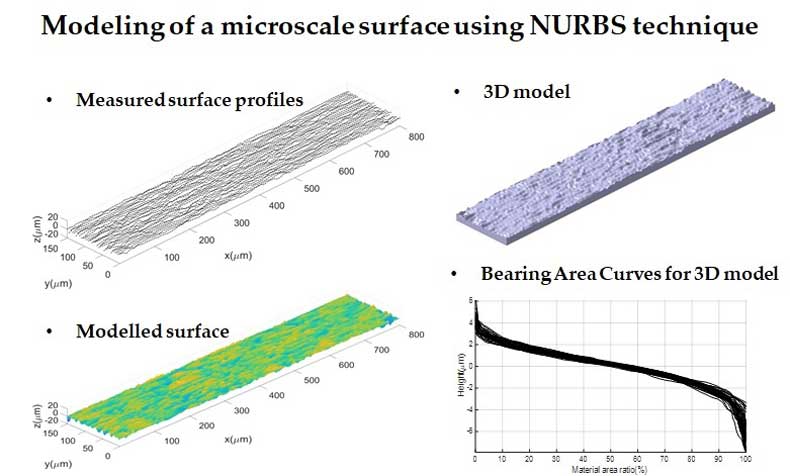
Digital 3D Sculpting
Sculpting returns us to the more traditionally creative side of 3D modeling, apart from the technical component. Vertices faces, and edges are used in sculpture precisely the way they are in box modeling and polygon modeling.
To distinguish the shaping process from the more technical aspects of thinking about the specific pieces, we utilize sculpting. We have brushes instead of altering them based on selection. Depending on the brush type and parameters, the brush has an influence area and more naturally reshapes the geometry.
Sculpting is typically employed for creating characters, animals, or other living things. However, it can also be utilized to sculpt fine details that are difficult to achieve with conventional box and polygon modeling.
There are various forms of sculpture. The vertices, edges, and faces of the mesh might be moved around to take on the shape of the brush if we choose to sculpt it as is. With this approach, we must have a substantial amount of geometry available right away, or else we will quickly exceed the maximum amount of detail that our geometry can store.
Through various remesh methods, we can sometimes automatically create a better mesh by applying a new mesh on top of the surface of the item. Retopology is a procedure that frequently requires us to reconstruct the mesh by hand on top of the sculpted object. It is also elaborated on all you need to know about 3D digital sculpting.
Dynamic topology is the name of the following technology iteration. In Blender, at least. Depending on the zoom level or a predetermined absolute level, this function dynamically divides the mesh into triangles as we paint. By doing it in this manner, the geometry will change as we continue to carve.
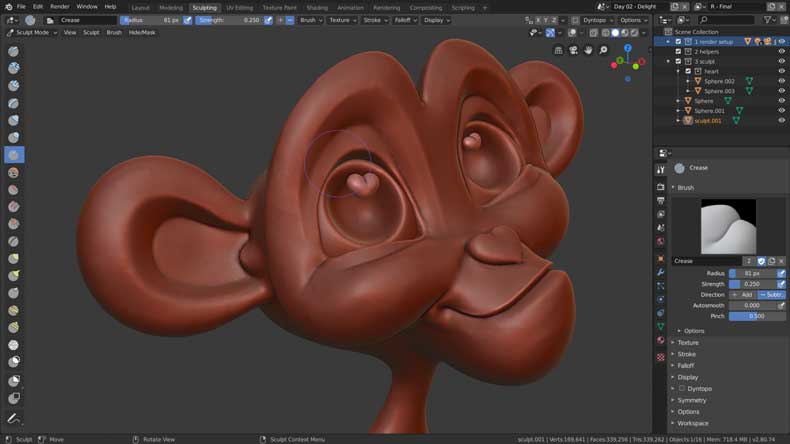
Photogrammetry
Another entirely unique method of creating 3D models is photogrammetry. Using a camera, we picture an object numerous times while using this technique, trying to make sure the lighting is as even as possible. We then input these photos into software, which decodes them and creates a 3D model of the thing.
There are clear benefits and drawbacks to this technique. We obtain real-world data therefore anything we produce is obligated to resemble reality. We frequently build UV Maps and texture baking as part of the process, saving us time in those areas as well.
The mesh must be revised, though, much like in sculpting, either through remesh or retopology. This implies that the UV Map may also need to be recreated. Since the camera will capture the subject-object and its surroundings, there will also be a significant amount of cleanup required.
Another drawback is that we must have the thing available to photograph it, and since we must place it on a surface, we will be unable to access some of the objects. For instance, a rock will need to be on its side while we shoot it because we can’t get to the underside in one shot. Our mesh will develop holes as a result, which we must somehow deal with.
A relatively recent invention that has gained a lot of popularity is photogrammetry. We can’t only take pictures of tiny things. A drone can also be used to photograph a large region and recreate more substantial constructions. This is encouraging for historic preservation efforts or quick area studies.
Similar to how sonar functions, there are scanners that may be used to scan an object or an area. The data can then be used to generate a 3D map using a piece of software.
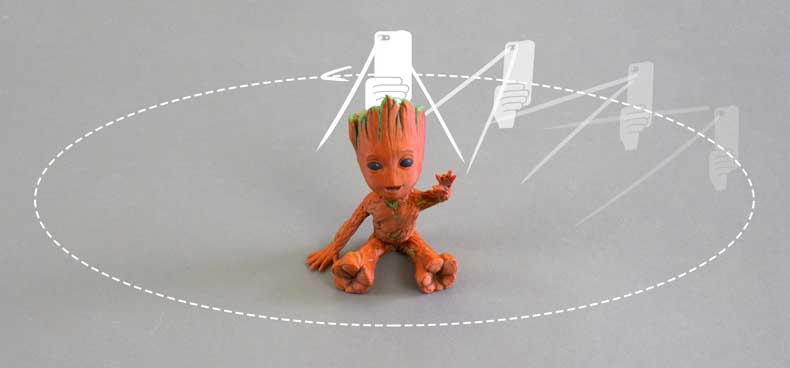
Simulation
Digital simulations come in a wide variety. Here are a few of them:
- Physics Simulation
- Cloth Simulation
- Smoke and fire Simulation
- Liquids Simulation
Each of these serves a distinct function. As you may undoubtedly understand, the majority of them also serve numerous functions. When we simulate something, we set up a scenario with many elements that will eventually interact with one another. For each frame for which we run the simulation, the computer estimates how objects will move and what will happen.
The outcome can then be used to produce animation as well as scenes or objects that are created through simulation as opposed to manual input from other modeling techniques. Imagine making a wave that would splash against a rock.
The rock can be modeled or created using photogrammetry, but the wave is more challenging. You might be able to sculpt it, but it would be much more practical to run the simulation and have the water splash on the rock by itself, giving it the shape it needs based on variables like the angle -the wave hit the rock at- its size and velocity, and so on.
Similar to this, we might simulate an automobile accident using physics and a soft body object rather than needing to manually model every frame. A simulation of fabric would be another illustration. You may either utilize a fabric simulation to build the pillows for your next architecture visualization scene, or you can sculpt the pillows by hand. Compared to NURBS, simulations lean far more toward VFX. However, as it may be used to build or deform objects, we can still classify it as a modeling technique.
A considerably more technical kind of 3D modeling is simulation. Since we don’t really concentrate on the shape, we mostly adjust and fine-tune parameters.
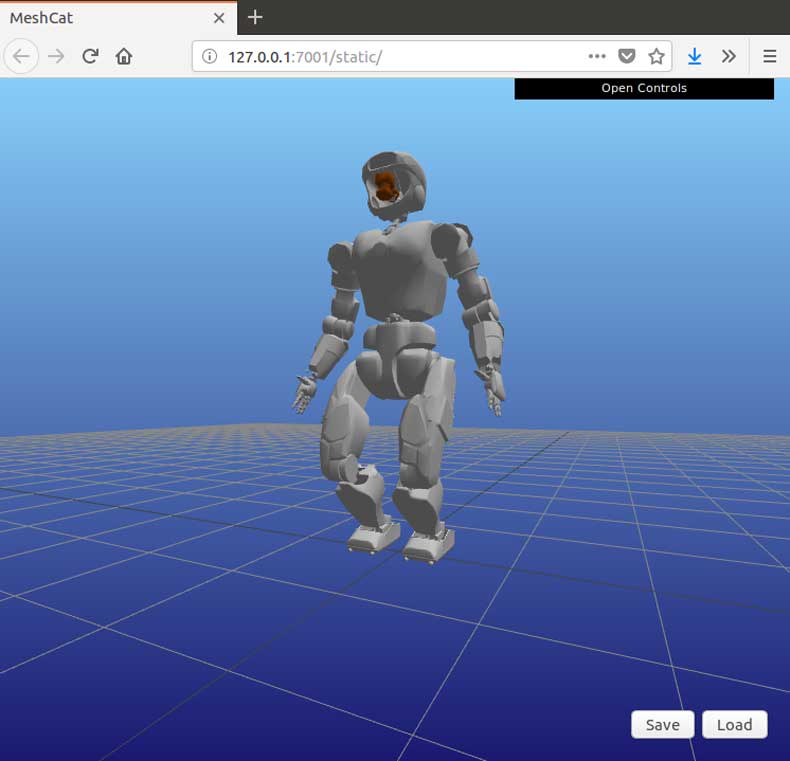
Procedural Modeling
Procedural modeling can take many different forms. This will be divided into two categories of modeling. The first one is based on a tool. A tool that is intended to procedurally produce a number of related objects was developed by us or someone else.
For instance, we might have a generator for the building. Then, we could enter a number of factors, such as the number of stories, the ceiling height, and the type of roof form. The program is then repeated a number of times, producing a fresh model that satisfies our requirements each time.
There are many such tools for particular kinds of models, and we can also build our own model generators and expose particular parameters that are appropriate for the kind of model we want the tool to produce.
The subsequent procedural modeling style is strongly related to shading. An output from a shader called displacement allows us to alter a simple primitive like a sphere or a plane using mathematical formulas to create a more complicated object or surface. Here, we have a procedural modeling of a tree.
As more and better tools have become available to replace geometry through shading, this trend has gotten stronger. It is possible to use vector displacement in addition to the conventional displacement that only uses one up and down axis. Geometry can be displaced by vectors in all directions, creating complex objects from simple geometry.
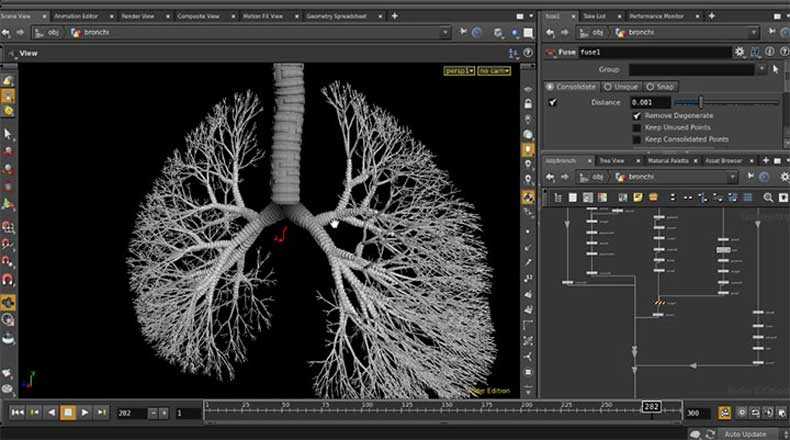
Boolean Modeling
In boolean modeling, we begin with a model and remove portions of it or add new components to it to produce a new shape. This is closely related to box modeling, and we frequently combine the two methods.
Typically, fundamental shapes are modeled using box modeling, and various shapes are subsequently combined using boolean operations. The operations that we must use are as follows:
- Difference
- Union
- Intersect
The most popular operator is the difference operator. This operator separates the volume and shape of one item from another. Boolean allows us to quickly design shapes that would otherwise take a lot of time to replicate using other modeling methods. Square hard-surface shapes can be added, subtracted, or combined with curved or bending shapes. Don’t miss the blender tutorial for the boolean modifier.
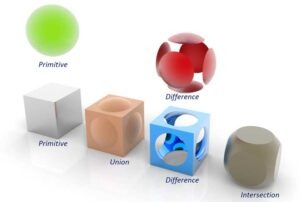
Kitbashing
In this different kind of modeling, we start with a kit of components and then combine them to create more intricate models. Or, we might utilize kit bashing to add details to something that was created using another kind of modeling.
When making products with a hard surface, kitbashing is also highly prevalent. With no requirement for a complete representation of what the finished object would look like, it enables us to investigate how various elements might fit together.
The best way to detail a scene is via kitbashing. The proportion of high-frequency, middle-frequency, and low-frequency information should be considered during kitbashing. Shots that have been expertly composited typically feature a nice balance and arrangement between various distributions of details.
This holds true for both modelings of organic and hard surfaces. For instance, a hypothetical robot’s head or another focal point might have more detail, and a forest might have a different distribution of plants, trees, and mushrooms depending on where each one would grow most successfully. While some are dispersed equally around the picture, others are grouped together or concentrated in one particular region regarding your storyboard. Figure out the benefits of animation storyboards.
Modular Modeling
Although not precisely a modeling technique, this is a useful exercise. It is a good idea to keep modularity in mind when designing 3D components. We might be constructing a cityscape. We might need to model a number of comparable buildings. In that instance, modularity should be considered in order to reuse some components from one building to another. To generate variation, we can even model various architectural elements that can be rearranged in various ways.
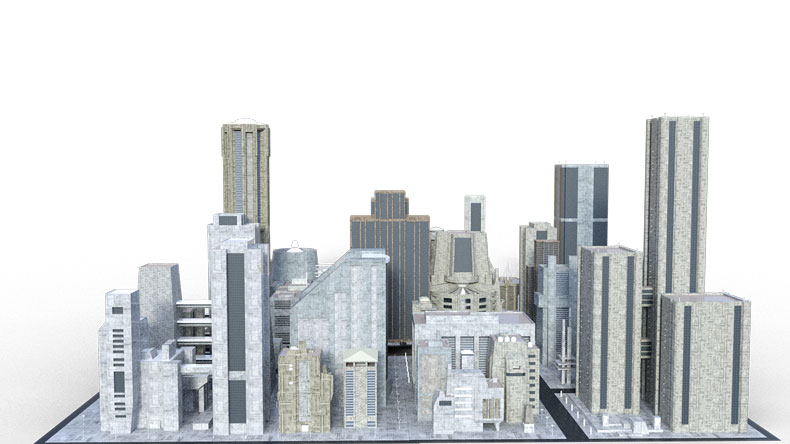
Applications of 3D Modeling Techniques
Here is a list of some applications for these modeling techniques. It’s only to give you a basic picture:
- Preproduction and product design
- Advertising and marketing
- Visualization of architecture
- VR and AR
- 3D printing
- Real-time applications and games
- Movies and animation
- Visual effects/VFX
- Mobile apps
- Engineering and business
What Does a 3D Modeler Do?
The need for 3D modeling services is high since studios and small businesses that engage in the creation of video games, as well as in the film and animation industries, place a lot of emphasis on the appearance of characters. This is actually one of the most crucial and in-demand jobs, and to be honest, the competition in this field is fierce because there are so many talented artists. However, this should not deter you from pursuing it if this is what you want to do.
Environment Artists
One of the most popular 3D careers that can be found interesting is environment art because it is just enjoyable and gratifying to be a part of. You’ll be collaborating directly with level designers as an environment artist, which means you’ll be shaping the level or sequence that the studio will develop for outdoor backdrops, background art, and visuals for movies and video games. In short, you will be building worlds that people may enter, which is fantastic, to say the least.
3D Asset Modeling
One of the most sought-after careers in 3D modeling is 3D asset modeling. As developing 3D assets is regarded as a complimentary yet essential duty for all projects, this type of artist forgoes freelancing or contract work in favor of working in studios full-time or even permanently. Whatever your specialty, you will be required to design a broad variety of items and things, including furniture, vehicles, weapons, and more. In general, these artists produce all the props for films, animations, and video games.
Architectural Visualization
For those who are interested, working as 3D artists, or more specifically, visualization artists, can be quite enjoyable. These individuals collaborate closely with architects, which requires them to interpret blueprints and designs for buildings as well as those for homes and interiors in an effort to simplify and visualize plans for clients prior to their execution and construction.
3D Printing
Despite being a relatively new field, 3D printing is unexpectedly a booming business, with companies popping up all over to provide customers with a wide range of printing services. If you’re wondering what a 3D modeler does, they generate 3D models, sort of operate the printers by tweaking and optimizing 3D products and things for the devices, and produce excellent 3D-printed creations quickly.
Are you wondering about how to become an outstanding animation modeler?
Finally, as Christy Turlington says, Modeling is a profession where your worth is tied up with looks.
Let Pixune Studios Do It for You!
If you lack the expertise, time, or resources to create 3D models and content of your own, you can surely turn to a studio like Pixune. We have a long history of creating both 2D and 3D content for different business verticals and even working with other formats like animation and VFX.
Whichever 2D or 3D animation services you are looking for, we will be happy to turn your thoughts and concepts into detailed and gorgeous assets that you can use and reuse. To discuss your project and how we might cooperate on it, be sure to keep in touch with us at Pixune 3D animation outsourcing company!

Need 3D Animation Services?
Visit our 3D Animation Service page to see how we can help bring your ideas to life!
Final Words
3D modeling techniques are essential in order to create realistic and attractive 3D images. With the right techniques, you can craft amazing digital scenes and objects that will appeal to viewers. By following our tips on choosing an appropriate program, selecting a subject, familiarizing yourself with important tools, creating basic shapes, and refining your models for detail, anyone can successfully master the art of 3D modeling. Don’t be afraid to give it a try – with practice comes perfection! If you get any practical technique not mentioned in this article, the comment section is all yours.


